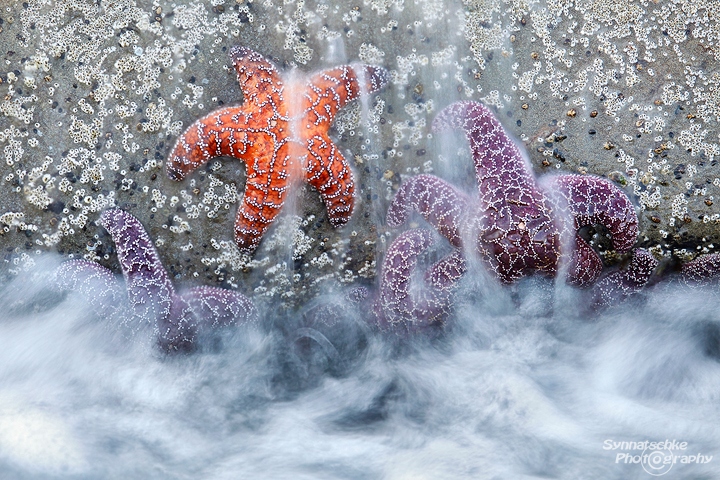
OCEAN'S EMBRACE
Surf softly embracing the Ochre Sea Stars (Pisaster ochraceus) on a rock
This month's image was awarded last weekend at the "European Wildlife Photographer of the Year 2015" ceremony in the category "Other Animals" and it was shown at the exibition at the renowned International Nature Photography Festival in Lünen, Western Germany. Don't miss taking a look at all the other awarded images, many of them are truly breathtaking! They were also published at the website of the Society of German Nature Photographers (GDT).
I took this image back in June 2011 along the Oregon Coast at Cape Kiwanda, United States. I hoped for a great sunset at those famous cliffs, but since the sun decided not to show up that day and the clouds didn't look promising either, I had to watch out for other and different compositions. My eyes were soon caught by these colorful sea stars sitting on the rocks and I loved the way they were softly embraced by the incoming tide.
Our favorite place for spotting sea stars along the rugged coastline in the American Pacific Northwest is Shi Shi Beach as well as Third Beach at the Olympic National Park, WA. Extreme high and low tides occur around winter and summer solstice (check tide tables here or "annual pdf" e.g. here), so June usually is one the best months for shooting sea stars and tidepools. The most exotic and beautiful starfishes such as the sunflower seastar (Pycnopodia helianthoides), tiny blood stars (Henricia leviuscula) or bat stars (Asterina miniata) will be only visible starting at a good minus low tide (< -1.5 ft, or better < - 2 ft). Ochre sea stars may also show up at higher grounds, even in the "mid tide zone", and can be seen during regular low tides at < +2 ft.
Sea stars used to be very common along the Pacific Coast until summer 2013, when they suddenly started dying by the millions due to a so-called "sea star wasting syndrom" (SSWS), which leads to fallen off limbs and body disintegration. In some parts of Canada and the United States up to 95% of the sea star population has mysteriously died off since then. Global warming, El Nino and radioactive waste from Fukushima's Nuclear Power Plant were monitored, but most probably their massive deaths is rather linked to a virus. If you are interested in further details and the latest reports, please also check out the official USCS website.
Image data: 1/5 s at f/16, ISO 320; Canon EF 100-400mm 1:4.5-5.6 L IS USM at 260 mm, Canon EOS 5D Mark II
Related Links: More images from the Pacific Northwest
